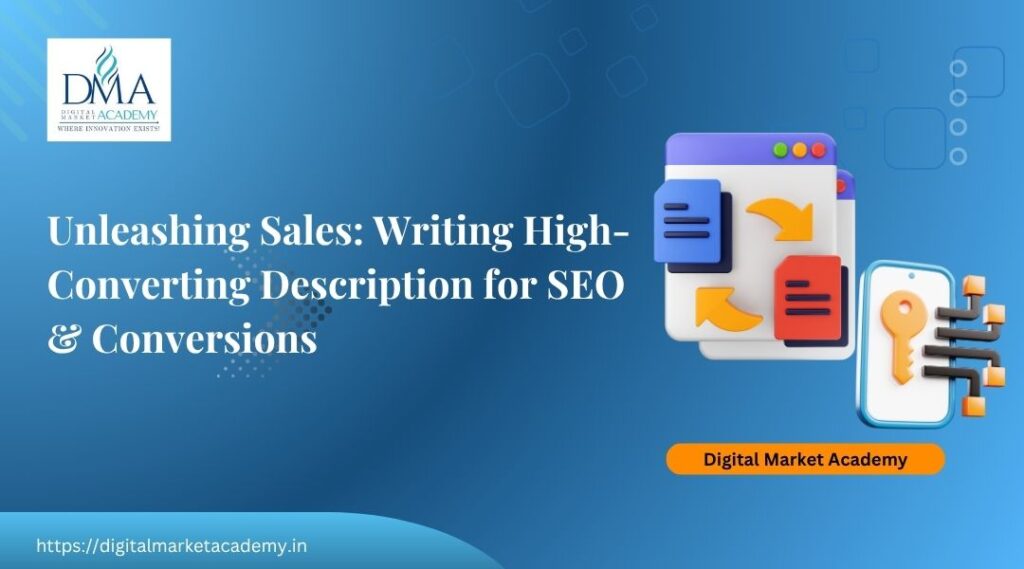The Art and Science of High-Converting Product Descriptions
In the crowded digital marketplace, a product image might grab attention, but it’s the product description that seals the deal. Beyond merely listing features, a truly effective product description speaks directly to the customer, addressing their needs, solving their problems, and painting a vivid picture of how their life will improve with your product. This is the essence of High-Converting Product Descriptions: a powerful blend of compelling copy, strategic keyword integration, and persuasive elements designed to drive both organic search visibility and, crucially, sales.
Think about the last time you bought something online in India. Did you just look at the price, or did you read about what the product does for you? Crafting High-Converting Product Descriptions means going beyond bland specifications. It’s about telling a story, appealing to emotions, and subtly guiding the customer towards a purchase, all while providing rich, keyword-optimized content that helps search engines understand and rank your product page. This strategic approach ensures your products are not only found but also irresistibly appealing, transforming browsers into loyal buyers.
Why High-Converting Product Descriptions are a Dual Win for SEO and Sales
Many online businesses view product descriptions as a simple necessity, often overlooking their immense potential. In reality, they are a powerful, often underutilized, asset that serves two critical masters: search engine optimization (SEO) and direct sales conversion. This dual role makes them indispensable for any online retailer aiming for sustained growth.
From an SEO perspective, High-Converting Product Descriptions provide search engines with the text they need to understand what your product is, what problems it solves, and who it’s for. This rich content, when infused with relevant keywords and LSI terms, helps your product pages rank higher for a multitude of queries, including long-tail and conversational searches. For example, a description for a saree that explains its fabric, occasion, and styling opportunities gives Google far more context than just “Red Saree.”
From a sales perspective, these descriptions are your digital salesperson. They answer questions, overcome objections, highlight benefits, and evoke desire. They transform abstract features into tangible advantages, making the product irresistible. A compelling description can reduce bounce rates, increase time on page, and directly influence the “Add to Cart” decision. Neglecting this crucial copy means leaving money on the table and missing out on valuable organic traffic.
The Synergy: How SEO-Optimized Copy Drives Sales
The beauty of High-Converting Product Descriptions lies in their synergy. Content that is good for SEO is increasingly good for users, and vice-versa. Google’s algorithms, driven by helpful content and E-E-A-T (Experience, Expertise, Authoritativeness, Trustworthiness), reward pages that provide comprehensive, genuinely useful information. When your product description clearly explains what a product does, who it benefits, and why it’s superior, you’re not just optimizing for search engines; you’re building trust and solving a customer’s problem.
Consider a search for “best air purifier for Delhi pollution.” A product description that clearly articulates the purifier’s CADR, filter types (HEPA, activated carbon), coverage area, and how it tackles PM2.5 and allergens, will not only rank well but also directly persuade a worried customer. This alignment of SEO and sales goals makes investing in quality product descriptions a non-negotiable part of your digital strategy.
Mastering the Art of Persuasive Product Copy
Beyond keywords, the true magic of High-Converting Product Descriptions lies in their ability to persuade. This involves understanding your audience, appealing to their emotions, and guiding them through a narrative that culminates in a purchase. It’s about moving from “what it is” to “what it does for me.”
Focus on Benefits, Not Just Features
This is arguably the most crucial principle in persuasive copywriting. Features are facts about your product (e.g., “5000 mAh battery,” “12MP camera”). Benefits are what those features do for the customer (e.g., “Enjoy all-day power without constant recharging,” “Capture stunning, professional-quality photos even in low light”). Customers buy solutions to their problems, not just products.
Table: Features vs. Benefits in Product Descriptions
Feature | Corresponding Benefit | Emotional Appeal |
Water-resistant fabric | Stays dry & comfortable in monsoon rains; easy to clean spills. | Peace of mind, convenience |
Ergonomic design | Reduces strain during long use; feels natural in hand. | Comfort, productivity |
Fast charging (65W) | Get hours of power in minutes; never wait long to get going. | Efficiency, spontaneity |
When writing for an Indian audience, consider relatable benefits. For a pressure cooker, instead of just “stainless steel construction,” emphasize “durable, rust-free for years of hassle-free cooking in an Indian kitchen,” or “cook authentic Indian curries faster, saving precious time for family.”
Crafting a Compelling Narrative and Tone
Every product has a story. Your description should tell it. Who is this product for? What problem does it solve? What experience does it offer? Using sensory language (“silky smooth,” “crisp audio,” “invigorating aroma”) can transport the reader. The tone should match your brand voice and resonate with your target audience. Is it sophisticated, playful, practical, or inspirational?
For a traditional South Indian silk saree, don’t just describe the silk type. Evoke the feeling: “Drape yourself in the timeless elegance of Kanjivaram silk, a masterpiece handcrafted in the looms of Tamil Nadu, perfect for grand celebrations and making memories.”
Incorporating Strong Calls to Action (CTAs)
Every High-Converting Product Description needs a clear, compelling call to action. Don’t assume the customer knows what to do next. Guide them! Use action-oriented verbs and create a sense of urgency or exclusivity where appropriate.
Examples: “Add to Cart Now for Instant Savings,” “Shop Today & Experience the Difference,” “Get Yours Before They’re Gone.” Make it easy and appealing to take the next step.
Strategic Keyword Integration for SEO and Discovery
While copy drives sales, keywords drive discovery. Integrating your target keywords naturally into your product descriptions is vital for ensuring your products appear in relevant search results. This goes beyond simple keyword stuffing.
Researching Product-Specific Keywords
Your keyword research for product pages should be highly specific. Consider:
- Long-tail keywords: “Bluetooth headphones for running with mic” or “organic cotton baby clothes for summer.”
- Brand names: “Samsung 5G smartphone” if you sell Samsung.
- Model numbers: “Mi TV 5X 55-inch”
- Product attributes: “vegan leather handbag,” “gluten-free atta”
- User intent terms: “buy online,” “price,” “reviews”
Use tools like Google Keyword Planner, Ahrefs, Semrush, and Amazon’s autofill suggestions to find these detailed terms.
Natural Keyword Placement and LSI Keywords
Keywords should flow naturally within your product description. Avoid forcing them in. Focus on readability first. Google’s algorithms are sophisticated enough to understand context and synonyms. Weave your primary keywords and related LSI keywords (e.g., for “men’s formal shirts,” include “office wear,” “business attire,” “dress shirts,” “collar types,” “cuff styles”) into the headlines, body paragraphs, and even bullet points.
- Product Title (H1): This is the most crucial place for your main product keyword.
- First Paragraph: Naturally introduce your primary keyword and its most important synonyms.
- Bullet Points / Features List: Incorporate keywords when describing features and benefits.
- Subheadings (H3, H4): If your description is lengthy, use subheadings to break it down, including keywords where relevant.
Remember, the goal is to describe the product comprehensively using the language your customers use, which naturally includes keywords.
Optimizing Product Attributes and Schema Markup
Beyond the main description, proper optimization of product attributes (size, color, material, weight, etc.) is critical for SEO. These attributes can populate filters and faceted navigation, and they feed into structured data. Use descriptive, keyword-rich attribute values.
Implement Product schema markup (and potentially Offer, AggregateRating schema) on your product pages. This explicitly tells search engines details about your product, its price, availability, and reviews, often leading to rich snippets in search results, which can significantly boost click-through rates. These structured data elements provide clear signals for High-Converting Product Descriptions to be recognized for rich results.
Persuasive Elements and Trust Signals
Even the most well-written, keyword-rich description needs persuasive elements and trust signals to convert effectively. These are the subtle nudges that build confidence and overcome customer hesitation.
Addressing Pain Points and Offering Solutions
Empathy is powerful. Understand your customer’s pain points and position your product as the ideal solution. For someone in Mumbai struggling with hard water, a water softener description could highlight “say goodbye to hard water stains and dry skin.” For someone in Chennai dealing with power cuts, an inverter battery description could emphasize “uninterrupted power for your home, even during long outages.”
Building Trust: Reviews, Guarantees, and Social Proof
Online shoppers are wary. Build trust directly within your product description:
- Highlight Reviews: Mentioning “loved by over 10,000 customers in India” or “4.8-star rating on Flipkart” adds immense social proof.
- Money-Back Guarantees/Warranties: Clearly state return policies or product warranties.
- Security Badges: If space permits, subtly mention secure payment gateways. For further insights on building trust online, explore strategies for building trust online.
- Certifications: If your product has relevant certifications (e.g., organic, ISI certified), mention them.
Creating Urgency and Scarcity (Ethically)
When used ethically, urgency (“Limited Stock!,” “Sale Ends Soon!”) and scarcity (“Only 3 Left!”) can encourage immediate action. However, only use these if genuinely true, as misleading tactics can damage trust. Consider phrases like “Popular Choice!” or “Fast-Selling Item” for a softer approach.
Optimizing for Mobile and Voice Search
With a significant portion of Indian online shoppers accessing the internet via mobile and increasing adoption of voice assistants, your High-Converting Product Descriptions must be optimized for these channels.
Mobile-First Product Descriptions
Mobile screens are small, and attention spans are shorter. Ensure your descriptions are:
- Scannable: Use short paragraphs, bullet points, and bold text.
- Concise: Get to the point quickly.
- Easy to Read: Use a legible font size and sufficient line spacing.
- Prioritize Information: Put the most important benefits and features at the top.
A mobile-first approach ensures a seamless experience, which is crucial for conversions.
Voice Search Optimization for Products
People use voice search differently than text search – they ask questions. Optimize your product descriptions to answer common voice queries:
- Conversational Language: Write in a natural, conversational tone.
- Address Questions Directly: Include phrases like “What does this product do?” or “Is this product good for X?” and answer them concisely.
- Attributes: Ensure your product attributes are clearly defined and structured, as voice search often relies on these.
Consider how someone might ask their smart speaker: “Hey Google, where can I buy a comfortable office chair online in Bangalore?” Your product descriptions for office chairs should ideally contain keywords and benefits that address such a query.
Measuring and Refining Your High-Converting Product Descriptions
The work doesn’t end once the description is published. Continuous monitoring and A/B testing are vital to ensure your High-Converting Product Descriptions are performing optimally and adapting to changing customer preferences and search algorithms.
Key Performance Indicators (KPIs)
- Conversion Rate: The most direct measure. How many product page visitors convert into buyers?
- Add-to-Cart Rate: How many visitors add the product to their cart?
- Bounce Rate & Time on Page: High time on page and low bounce rate indicate engaging content.
- Organic Rankings: Track keyword rankings for your product pages.
- Rich Snippet Impressions/Clicks: Monitor these in Google Search Console.
- A/B Testing Results: Measure the impact of different headlines, calls to action, or benefits. For relevant insights, review case studies on conversion rate optimization.
Iterative Improvement Through A/B Testing
Regularly A/B test different elements of your product descriptions:
- Headlines: Does a benefit-driven headline outperform a feature-driven one?
- Opening Paragraphs: Does a direct problem-solution opening work better?
- Call to Action: Does changing the text or button color affect conversions?
- Image Placement: Does placing specific images within the text improve understanding?
- Length: Is a shorter or longer description more effective for a particular product type?
By continuously testing and refining, you can unlock incremental gains in both SEO performance and sales from your product descriptions. This iterative process is crucial for achieving High-Converting Product Descriptions consistently.
Internal Linking: Connecting Your Online Retail Universe
Internal links are vital for any online store. They act as pathways, guiding both your visitors and search engine crawlers through your website. When you link relevant pages within your site, you enhance user navigation, helping shoppers discover more products and related content. Critically, these links also distribute “link equity” and signal to search engines the importance and thematic relationships between different pages on your site. This helps search engines understand your site’s structure and the topical authority of your product pages, ultimately boosting their visibility. Ensuring a robust internal linking strategy means making it easy for users to find what they’re looking for, while simultaneously telling search engines which pages are most valuable.
This guide on high-converting product descriptions is a crucial part of a broader strategy for Mastering E-commerce SEO and Conversion Optimization.
When linking, use descriptive and relevant anchor text that includes your product names or related terms.
FAQ: Your Questions About High-Converting Product Descriptions Answered
A High-Converting Product Description goes beyond listing features; it focuses on benefits, tells a compelling story, addresses customer pain points, uses persuasive language, and includes clear calls to action. It also subtly integrates relevant keywords for SEO, ensuring the product is discoverable, and incorporates trust signals like reviews and guarantees to build customer confidence and drive sales.
Keywords are crucial for SEO, helping search engines understand what your product page is about. For High-Converting Product Descriptions, this means naturally incorporating primary product keywords, long-tail variations, and LSI keywords into the title, headings, and body. This helps your product appear in relevant search results, attracting qualified traffic that is already looking for what you offer, thereby improving discovery alongside direct sales.
While features (what a product is) are important for specifications, High-Converting Product Descriptions should predominantly focus on benefits (what a product does for the customer). Customers buy solutions and experiences, not just raw specifications. For example, instead of just "12MP camera," emphasize "capture stunning, high-resolution photos of your family moments." Highlighting benefits resonates emotionally and directly addresses customer needs, making the product more appealing.
Trust signals are extremely important for High-Converting Product Descriptions and direct sales. Online shoppers are naturally cautious. Integrating elements like positive customer reviews, clear return policies, warranties, security badges, and certifications directly into your description helps build confidence and overcome purchase hesitations. These signals validate your product's quality and reliability, making customers more comfortable buying from you.
With increasing mobile usage and the rise of voice assistants in India, optimizing product descriptions for these channels is vital. For mobile, descriptions need to be scannable, concise, and easy to read on smaller screens. For voice search, focus on conversational language and structuring content to directly answer questions, as users often ask voice assistants specific questions about products. This dual optimization ensures your High-Converting Product Descriptions reach customers wherever and however they search.
Conclusion: Elevate Your E-commerce with Exceptional Product Descriptions
In the dynamic world of online retail, High-Converting Product Descriptions are far more than just text on a page. They are strategic assets that simultaneously empower your SEO efforts and act as persuasive sales tools. By meticulously crafting copy that focuses on customer benefits, integrates relevant keywords naturally, builds trust, and is optimized for modern search behaviors like mobile and voice, you elevate your product pages from mere listings to powerful conversion engines.
Embrace the art of storytelling and the science of data to transform your product narratives. This commitment to exceptional product descriptions will not only boost your visibility in search results but also significantly enhance your sales figures, turning curious browsers into delighted customers. For those aspiring to master the nuances of E-commerce SEO and persuasive copywriting, including advanced techniques for crafting truly effective product pages, Digital Market Academy in Bangalore offers top-rated digital marketing training. Their comprehensive programs provide the practical skills needed to thrive in India’s competitive online business landscape, ensuring your descriptions don’t just inform, but also inspire action and drive remarkable results.

Rajesh Menon is a leading digital marketing trainer and strategist based in Bangalore, with over 15 years of experience in SEO, advertising, and digital growth planning. As the Founder and CEO of Digital Market Academy, he is known not just for his ability to teach, but for his visionary thinking and deep strategic insight.
At the academy’s Kasturinagar center, Menon leads classroom training programs and digital marketing boot camps. He also conducts on-campus sessions at colleges for undergraduate and postgraduate students, and provides digital enablement workshops for MSMEs and startups. His approach blends practical execution with long-term strategy, making him a trusted mentor for aspiring marketers and small business owners alike.
Rajesh writes regularly on the Digital Market Academy blog, and also shares expert content on Medium and LinkedIn, where his work is followed by both learners and industry peers.
You can find links to his Medium and LinkedIn profiles in the author box below.




